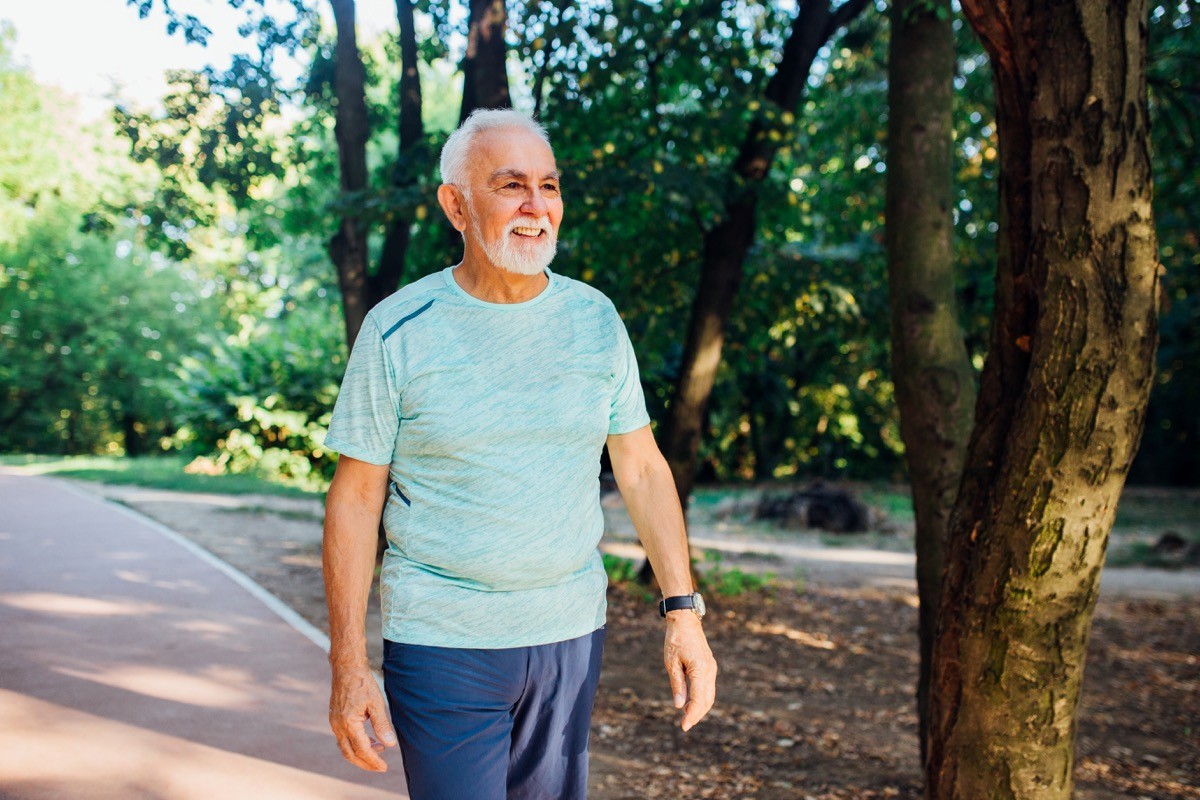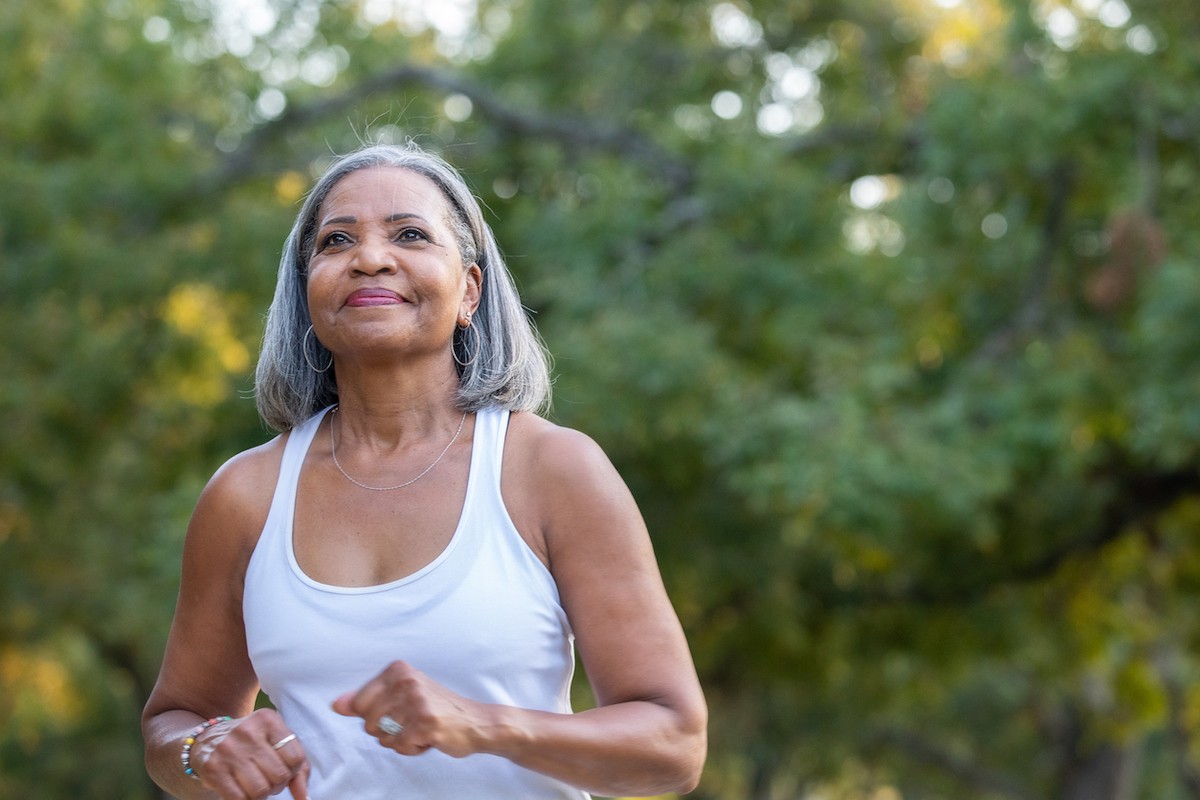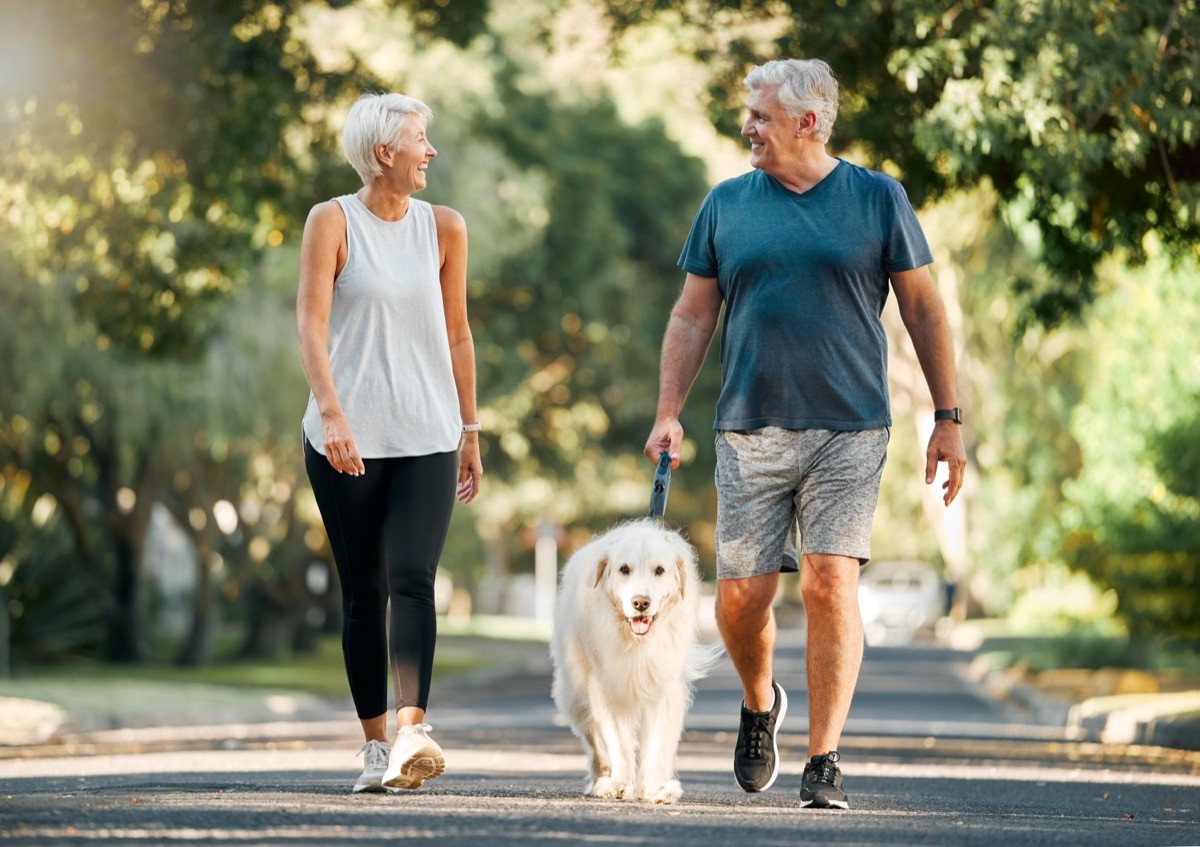The Top 4 Walking Routines for Weight Loss After 60, Trainers Say
Start tipping the scales, one step at a time.

Walking is one of the most accessible and effective forms of exercise, especially for those over 60. Not only does it support cardiovascular health, but it also aids in weight management, strengthens bones, and enhances overall well-being. However, as we age, our bodies require a more thoughtful approach to exercise, not least because an unfortunate injury can derail the very health you’re hoping to preserve and promote.
Alex Lee, PT, a licensed physiotherapist, strength coach, and co-founder of Saunny, says he’s spent years helping seniors build back their strength and flexibility after injury, both in a clinic setting and via wellness programs. “I’ve witnessed firsthand how transformational walking can be, particularly for adults 60 and older who wish to shed pounds and feel great in their body,” he tells Best Life. He says that whether you’re new to fitness or simply looking for a way to stay consistent, choosing the right walking routine can help optimize your results, particularly when it comes to weight loss.
Wondering how to get started? Here are four expert-approved routines that will turn walking into your fitness superpower.
RELATED: How to Walk 10,000 Steps a Day Without Leaving the House.
1
Japanese Walking: Blending Intensity and Recovery

The “Japanese Walking” routine, which is gaining traction for its efficiency and results, is a combination of interval walking and High-Intensity Interval Training (HIIT). Developed in Japan, it involves alternating between three minutes of slow walking and three minutes of brisk walking for a total of 30 minutes. This walking-HIIT hybrid maximizes fat burning, boosts metabolism, and is gentler on the joints compared to other high-intensity workouts.
Saurabh Sethi, MD, a board-certified gastroenterologist and interventional endoscopist, has said on social media that this routine is “joint-friendly, time-efficient, and very effective.” For those over 60, this type of interval walking is ideal because it avoids the risk of overexertion while still challenging your body for increased fat loss.
How to do it:
- Warm up with three to five minutes of light walking.
- Walk at a slow pace for three minutes.
- Walk briskly for three minutes (as if you’re rushing to an important meeting).
- Repeat the cycle for 30 minutes.
- Cool down with a few minutes of slow walking and stretching. Focus on lengthening your lower back, hamstrings, and calves—these are the areas most affected by walking and can help reduce muscle stiffness and soreness.
2
Zone Two Micro-Walks: A Gentle Yet Targeted Approach to Fat Burning

Recent research suggests that for individuals over 60, walking a minimum of 7,500 steps per day can significantly improve health outcomes, including weight loss. The 10,000 steps myth is actually based on a 1960s marketing campaign and isn’t scientifically grounded. This finding gives you a more attainable goal without feeling pressured to hit unrealistic numbers.
Milica McDowell, DPT, an exercise physiologist and VP of operations at Gait Happens, suggests taking shorter walks throughout the day that keep your heart rate in Zone Two. This refers to a specific heart rate zone (60 to 70 percent of your maximum heart rate) where your body primarily burns fat for energy, which is ideal for fat loss.
“You can take small walking breaks throughout the day. Five minutes is typically 500 steps, while 10 minutes is typically 1,000 steps—and that will get you up to your 7,500 goal,” she tells Best Life.
How to do it:
- Warm up with three to five minutes of light walking or gentle movement.
- Begin by calculating your zone two heart rate by subtracting your age from 220. For example, if you are 60, 220 – 60 = 160.
- Use a fitness tracker to ensure you’re walking in the right heart rate zone for optimal fat burning.
- Aim for around 180 steps per minute, but if you experience joint discomfort, try increasing your cadence to 190 steps per minute. Walking at a brisk pace helps maintain balance and reduces the risk of falls, which is especially important as we age.
- Cool down with a few minutes of slow walking and stretching.
3
The 6-6-6 Walking Routine: A Consistency Builder

If you’re looking to build an ironclad routine, some fitness experts recommend the 6-6-6 approach. Though the strategy suggests walking for 60 minutes a day, either at 6 a.m. or 6 p.m. to work around a typical workday, the exact time you choose won’t affect your progress. The key is to dedicate a time that you can reliably commit to.
The benefits of walking regularly in the morning or evening include improved blood circulation, enhanced fat-burning potential, and a reduced risk of chronic conditions such as diabetes and heart disease.
How to do it:
- Consider your schedule and pick your “walking hour”—a time of day that you can commit to physical activity.
- This routine also calls for a six-minute warmup and cooldown, which should include light walking and stretching.
- Consider adding more of a challenge by wearing a light weighted vest or carrying hand weights.
4
The Postprandial Walking Routine: A Blood Sugar Regulator

Taking a walk after eating—known as postprandial walking—is a highly effective, low-impact way to help manage blood sugar levels, especially for those over 60.
After meals, blood sugar naturally rises as the body processes the food. Walking helps mitigate this spike by using glucose for energy, improving insulin sensitivity, and supporting overall metabolic health. This simple habit can be an essential tool in preventing or managing type 2 diabetes and maintaining optimal health as you age.
Even a short, 10- to 15-minute walk can significantly lower your post-meal blood sugar and provide other benefits such as improved digestion, mood, and heart health.
“The intervals are helpful with burning calories and boosting the metabolism, and individuals can increase duration or intensity as they get stronger,” explains Baltazar Villanueva, PT, a personal trainer and nutrition coach at Relentless Spirit Personal Training & Nutrition.
“It’s also important to remind older adults that walking routines should be paired with awareness of posture, footwear, hydration, and recovery,” he adds. “Small changes, like walking on softer surfaces, choosing low-traffic times, or walking with a friend, can also increase safety and enjoyment.”
How to do it:
- Walk within 30 minutes to an hour after eating for the best effect.
- Walk at a comfortable, steady pace—no need for intensity.
- Aim for at least 10-15 minutes of walking, but feel free to extend it if you’re comfortable.
- Start by walking after one meal per day and gradually increase to after each meal if desired.
- Cool down with a five-minute stretch or stroll.





















